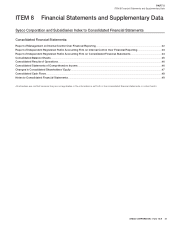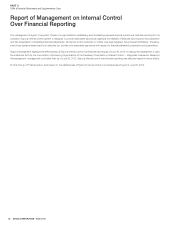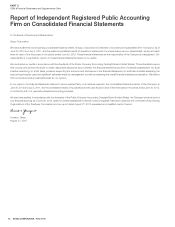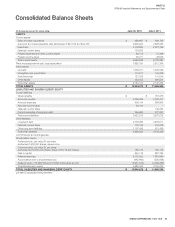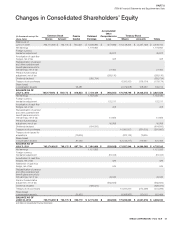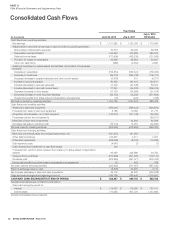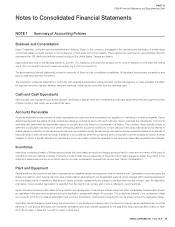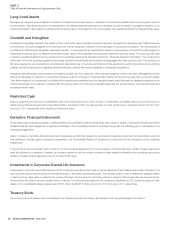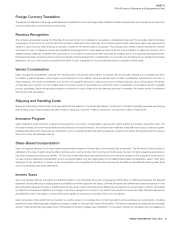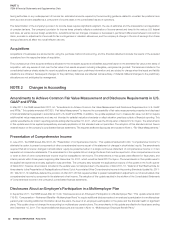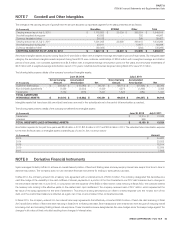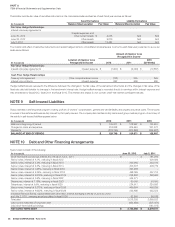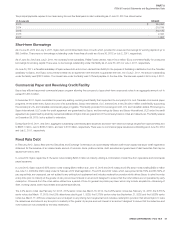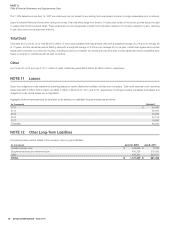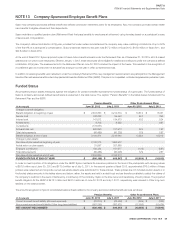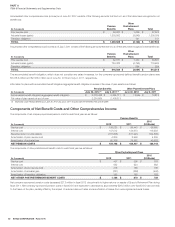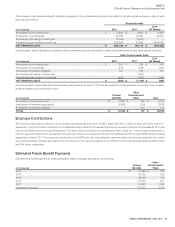Sysco 2012 Annual Report Download - page 74
Download and view the complete annual report
Please find page 74 of the 2012 Sysco annual report below. You can navigate through the pages in the report by either clicking on the pages listed below, or by using the keyword search tool below to find specific information within the annual report.SYSCO CORPORATION-Form10-K 51
PARTII
ITEM8Financial Statements and Supplementary Data
Foreign Currency Translation
The assets and liabilities of all foreign subsidiaries are translated at current exchange rates. Related translation adjustments are recorded as a component
of accumulated other comprehensive income (loss).
Revenue Recognition
The company recognizes revenue from the sale of a product when it is considered to be realized or realizable and earned. The company determines these
requirements to be met at the point at which the product is delivered to the customer. The company grants certain customers sales incentives such as
rebates or discounts and treats these as a reduction of sales at the time the sale is recognized. The company also makes incentive payments to certain
customers for new or renewed contracts and capitalizes these payments to other assets and amortizes them as a reduction of sales over the term of the
related contract. Sales tax collected from customers is not included in revenue but rather recorded as a liability due to the respective taxing authorities.
Purchases and sales of inventory with the same counterparty that are entered into in contemplation of one another are considered to be a single nonmonetary
transaction. As such, the company records the net effect of such transactions in the consolidated results of operations within sales.
Vendor Consideration
Sysco recognizes consideration received from vendors when the services performed in connection with the monies received are completed and when
the related product has been sold by Sysco as a reduction to cost of sales. There are several types of cash consideration received from vendors. In
many instances, the vendor consideration is in the form of a specifi ed amount per case or per pound. In these instances, Sysco will recognize the vendor
consideration as a reduction of cost of sales when the product is sold. In the situations in which the vendor consideration is not related directly to specifi c
product purchases, Sysco will recognize these as a reduction of cost of sales when the earnings process is complete, the related service is performed
and the amounts are realized.
Shipping and Handling Costs
Shipping and handling costs include costs associated with the selection of products and delivery to customers. Included in operating expenses are shipping
and handling costs of approximately $2,396.2million in fi scal 2012, $2,222.1million in fi scal 2011, and $2,103.3million in fi scal 2010.
Insurance Program
Sysco maintains a self-insurance program covering portions of workers’ compensation, general and vehicle liability and property insurance costs. The
amounts in excess of the self-insured levels are fully insured by third party insurers. The company also maintains a fully self-insured group medical program.
Liabilities associated with these risks are estimated in part by considering historical claims experience, medical cost trends, demographic factors, severity
factors and other actuarial assumptions.
Share-Based Compensation
Sysco recognizes expense for its share-based compensation based on the fair value of the awards that are granted. The fair value of stock options is
estimated at the date of grant using the Black-Scholes option pricing model. Option pricing methods require the input of highly subjective assumptions,
including the expected stock price volatility. The fair value of restricted stock and restricted stock unit awards are based on the company’s stock price on
the date of grant. Measured compensation cost is recognized ratably over the vesting period of the related share-based compensation award. Cash fl ows
resulting from tax deductions in excess of the compensation cost recognized for those options (excess tax benefi ts) are classifi ed as fi nancing cash fl ows
on the consolidated cash fl ows statements.
Income Taxes
Sysco recognizes deferred tax assets and liabilities based on the estimated future tax consequences attributable to differences between the fi nancial
statement carrying amounts of existing assets and liabilities and their respective tax bases. Deferred tax assets and liabilities are measured pursuant to tax
laws using rates expected to apply to taxable income in the years in which those temporary differences are expected to be recovered or settled. The impact
on deferred tax assets and liabilities of a change in tax rate is recognized in income in the period that includes the enactment date. Valuation allowances
are established when necessary to reduce deferred tax assets to the amount more likely than not to be realized.
Sysco recognizes a tax benefi t from an uncertain tax position when it is more likely than not that the position will be sustained upon examination, including
resolutions of any related appeals or litigation processes, based on the technical merits of the position. The amount recognized is measured as the largest
amount of tax benefi t that has greater than a 50% likelihood of being realized upon settlement. To the extent interest and penalties may be assessed by


